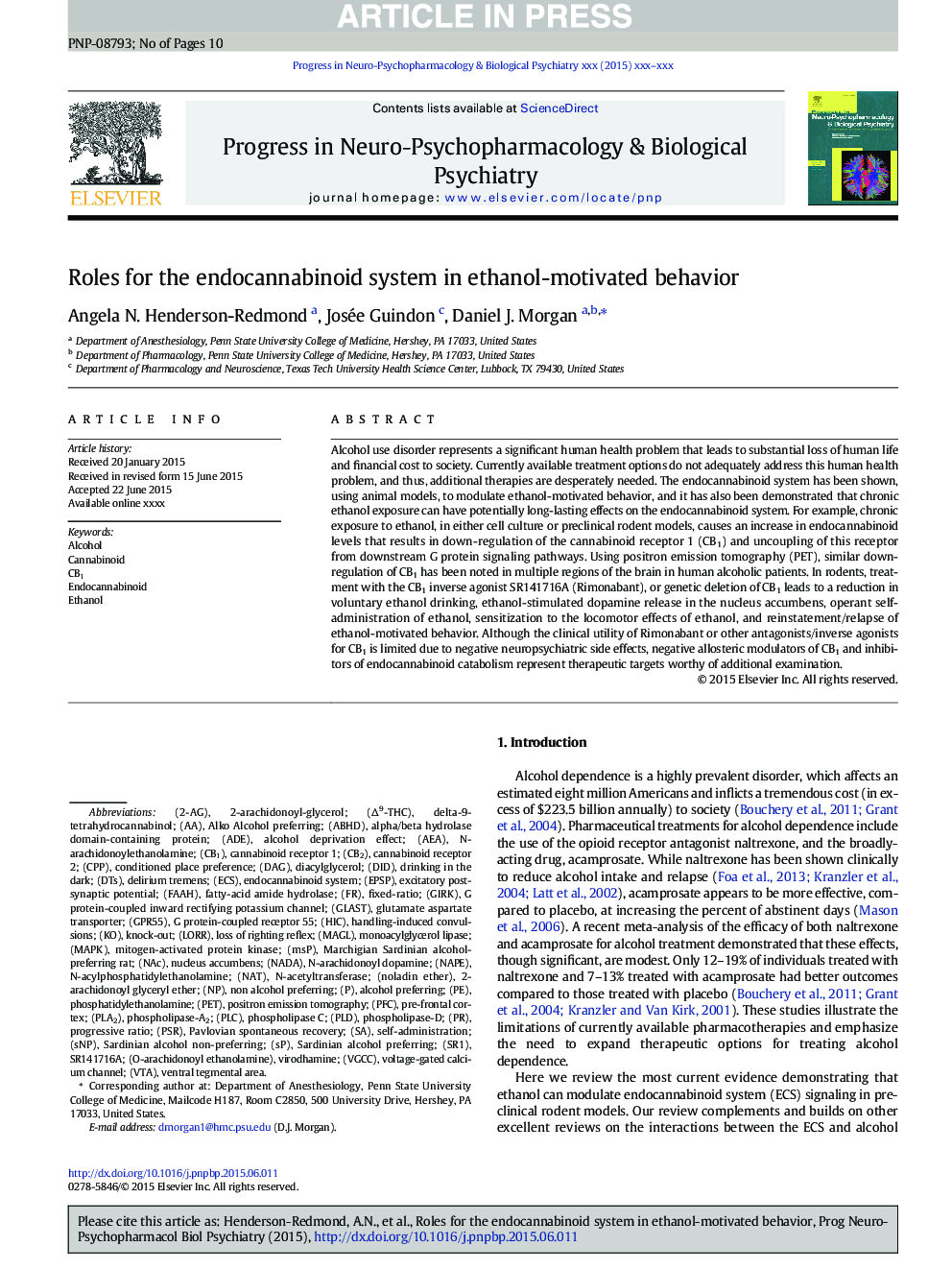| کد مقاله | کد نشریه | سال انتشار | مقاله انگلیسی | نسخه تمام متن |
|---|---|---|---|---|
| 5844240 | 1561029 | 2016 | 10 صفحه PDF | دانلود رایگان |
عنوان انگلیسی مقاله ISI
Roles for the endocannabinoid system in ethanol-motivated behavior
ترجمه فارسی عنوان
نقش سیستم اندوکانابینوئید در رفتار اخلاقی اتانول
دانلود مقاله + سفارش ترجمه
دانلود مقاله ISI انگلیسی
رایگان برای ایرانیان
کلمات کلیدی
Phospholipase-D(ECS)(PE)G protein-coupled receptor 55(VTA)(PFC)2-arachidonoyl-glycerol(AA)(SNP)(KO)(EPSP)SR141716AN-acylphosphatidylethanolaminealcohol preferring(MAPK)(PR)(PLC)phospholipase-A2(PET)(NP)CB1(NAc)N-arachidonoyl dopamineVirodhaminePavlovian Spontaneous RecoveryN-arachidonoylethanolamine(DAG) - (روز)(P) - (پ)N-acetyltransferase - N-استیل ترانسفرازendocannabinoid - آندوکانابینوئیدEthanol - اتانولAlcohol deprivation effect - اثر محرومیت الکلیLoss of righting reflex - از دست دادن رفلکس درست کردنFatty-acid amide hydrolase - اسید آمید هیدرولاز اسید چربAlcohol - الکلconditioned place preference - ترجیح محل موظف استHandling-induced convulsions - تصادفات ناشی از حمل و نقلPositron emission tomography - توموگرافی گسیل پوزیترونglutamate aspartate transporter - حمل و نقل آسپارتات گلوتاماتself-administration - خود ادارهdelta-9-tetrahydrocannabinol - دلتا 9-تتراهیدروکانیابینولDelirium tremens - دلواپسی لثهdiacylglycerol - دیسیل گلیسیرینendocannabinoid system - سیستم اندوکانبینیدphosphatidylethanolamine - فسفاتیدیلتانولامینphospholipase C - فسفولیپاز Cpre-frontal cortex - قشر پیش از جلوییmonoacylglycerol lipase - لیپاز monoacylglycerol لیپازventral tegmental area - ناحیه تگمنتوم شکمیknock-out - ناک اوتfixed-ratio - نسبت ثابتProgressive ratio - نسبت پیشرفتDrinking in the dark - نوشیدن در تاریکیNucleus accumbens - هسته accumbensexcitatory post-synaptic potential - پتانسیل پس از سیناپتی هیجان انگیزmitogen-activated protein kinase - پروتئین کیناز فعال با mitogenCannabinoid - کانابینوئیدvoltage-gated calcium channel - کانال کلسیم با ولتاژCannabinoid receptor 1 - گیرنده کانابینوئید 1cannabinoid receptor 2 - گیرنده کانابینوئید 2
موضوعات مرتبط
علوم زیستی و بیوفناوری
علم عصب شناسی
روانپزشکی بیولوژیکی
چکیده انگلیسی
Alcohol use disorder represents a significant human health problem that leads to substantial loss of human life and financial cost to society. Currently available treatment options do not adequately address this human health problem, and thus, additional therapies are desperately needed. The endocannabinoid system has been shown, using animal models, to modulate ethanol-motivated behavior, and it has also been demonstrated that chronic ethanol exposure can have potentially long-lasting effects on the endocannabinoid system. For example, chronic exposure to ethanol, in either cell culture or preclinical rodent models, causes an increase in endocannabinoid levels that results in down-regulation of the cannabinoid receptor 1 (CB1) and uncoupling of this receptor from downstream G protein signaling pathways. Using positron emission tomography (PET), similar down-regulation of CB1 has been noted in multiple regions of the brain in human alcoholic patients. In rodents, treatment with the CB1 inverse agonist SR141716A (Rimonabant), or genetic deletion of CB1 leads to a reduction in voluntary ethanol drinking, ethanol-stimulated dopamine release in the nucleus accumbens, operant self-administration of ethanol, sensitization to the locomotor effects of ethanol, and reinstatement/relapse of ethanol-motivated behavior. Although the clinical utility of Rimonabant or other antagonists/inverse agonists for CB1 is limited due to negative neuropsychiatric side effects, negative allosteric modulators of CB1 and inhibitors of endocannabinoid catabolism represent therapeutic targets worthy of additional examination.
ناشر
Database: Elsevier - ScienceDirect (ساینس دایرکت)
Journal: Progress in Neuro-Psychopharmacology and Biological Psychiatry - Volume 65, 4 February 2016, Pages 330-339
Journal: Progress in Neuro-Psychopharmacology and Biological Psychiatry - Volume 65, 4 February 2016, Pages 330-339
نویسندگان
Angela N. Henderson-Redmond, Josée Guindon, Daniel J. Morgan,
